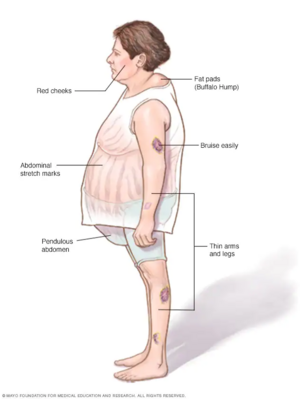Neck Hump: Difference between revisions
m (Added an image.) |
m (Visual edit.) |
||
| Line 9: | Line 9: | ||
</div> | </div> | ||
== Definition == | == Definition == | ||
[[File:Buffalo hump.jpg|thumb|T1 C+ sagittal MRI image of a case with non-capsulated cervicodorsal subcutaneous fat proliferation.]] | [[File:Buffalo hump.jpg|thumb|T1 C+ sagittal MRI image of a case with non-capsulated cervicodorsal subcutaneous fat proliferation.|left|301x301px]] | ||
The neck hump, also called buffalo hump, is a postural change that develops in the dorso-[[Cervical Anatomy|cervical]] area due to different causes such as postural issues, some of diseases, medications, [[obesity]] and genetic factors. | The neck hump, also called buffalo hump, is a postural change that develops in the dorso-[[Cervical Anatomy|cervical]] area due to different causes such as postural issues, some of diseases, medications, [[obesity]] and genetic factors. | ||
== Clinically Relevant Anatomy == | == Clinically Relevant Anatomy == | ||
Revision as of 22:04, 12 October 2023
This article or area is currently under construction and may only be partially complete. Please come back soon to see the finished work! (12/10/2023)
Original Editor - Sehriban Ozmen
Top Contributors - Sehriban Ozmen and Lucinda hampton
Definition[edit | edit source]
The neck hump, also called buffalo hump, is a postural change that develops in the dorso-cervical area due to different causes such as postural issues, some of diseases, medications, obesity and genetic factors.
Clinically Relevant Anatomy[edit | edit source]
The posterior region of the neck predominantly includes subcutaneous fat and skeletal muscle. [1]
See the page of the cervical anatomy or more pages on the cervical anatomy category for understanding more.
Aetiology[edit | edit source]
- Cervical Lipodystrophy: Refers to a metabolic change seen in HIV-infected patients receiving highly active antiretroviral therapy. Due to lipohypertrophy, localized abnormal fat accumulation may occur in the dorso-cervical area. [2]
- Dowager’s Hump: It refers to the curvature with a Cobb angle of more than 40 degrees in hyperkyphosis. [3] It can be due to muscle weakness or sensory deficits [4] and if left untreated can lead to functional limitations, increased risk of falls and vertebral fractures, and low quality of life. [3]
- Cushing's Syndrome: One of the signs of this syndrome is supraclavicular/dorsocervical fat pad (buffalo hump) with a prevalence rate of 50%. [5]
- Madelung's Disease: Also known as Launois-Bensaude Syndrome [6], is a rare disorder of adipose metabolism and refers to multiple, symmetrical lipomatosis / benign symmetric lipomatosis. [7][8] Nonencapsulated lipomas (fatty masses) can present in different parts of the body, including the neck. [9]
- Osteoporosis: One of the clinical symptoms of osteoporosis in older adults is dowager’s hump. [10]
- Obesity: A study [11] showed a meaningful difference between the obese and control group with more cases of adipomastia, and buffalo hump seen in the obese group.
- Genetics: Although any specific gene to cause buffalo hump has not been declared, it is known that some people may have a genetic predisposition to obesity and fat accumulation in certain areas of the body, thus having buffalo hump.
Treatment[edit | edit source]
Resources[edit | edit source]
References[edit | edit source]
- ↑ Moss WJ, Finegersh A, Narayanan A, Gillard D, Califano J, Brumund KT, Coffey CS, Orosco RK. Characterizing posterior neck masses: a single-institution retrospective and systematic review. Ear, Nose & Throat Journal. 2021 Sep;100(5_suppl):766S-70S.
- ↑ Carrese E, Morandi U, Stefani A, Aramini B. Total thyroidectomy in HIV positive patient with buffalo hump and taurine neck. International Journal of Surgery Case Reports. 2019 Jan 1;61:64-6.
- ↑ 3.0 3.1 Chau C, Chu EC, Huang KH, Tam D, Cheung G. Remission of Dowager’s hump by manipulative correction of spinal alignment: a case report. Journal of Medicine and Life. 2023 Jun;16(6):957.
- ↑ Chu EC, Wong AY. Cervicogenic dizziness in an 11-year-old girl: a case report. Adolescent Health, Medicine and Therapeutics. 2021 Nov 26:111-6.
- ↑ Savas M, Mehta S, Agrawal N, van Rossum EF, Feelders RA. Approach to the patient: diagnosis of Cushing syndrome. The Journal of Clinical Endocrinology & Metabolism. 2022 Nov 1;107(11):3162-74.
- ↑ Jang N, Shin HW, Kim J, Yoon KC. A case report of Madelung’s disease. Archives of Craniofacial Surgery. 2020 Oct;21(5):305.
- ↑ Tsilivigkos C, Mastronikolis S, Lygeros S, Tsilimpoti D, Papadas T. Multiple symmetric lipomatosis (Madelung's disease) with symptoms and signs of hypertension, lipodystrophy, and dyspnea: A case report and literature review. Clinical Case Reports. 2021 Jun;9(6):e04288.
- ↑ Liu SZ, Zhou X, Wang YP, Liu Y, Song A. The Madelung’s disease and the buffalo hump sign. QJM: An International Journal of Medicine. 2020 Mar 1;113(3):219-.
- ↑ Nisi G, Sisti A. Madelung's disease. New England Journal of Medicine. 2016;374(6):572-.
- ↑ Zhang Q, Cai W, Wang G, Shen X. Prevalence and contributing factors of osteoporosis in the elderly over 70 years old: an epidemiological study of several community health centers in Shanghai. Ann Palliat Med. 2020 Mar 1;9(2):231-8.
- ↑ Gün E, Uzun H, Bolu S, Arslanoğlu İ, Kocabay K. Serum 25-hydroxyvitamin D is associated with insulin resistance independently of obesity in children ages 5–17. Primary care diabetes. 2020 Dec 1;14(6):741-6.









